Abstract
Background: Immune-related adverse events (irAEs) are side effects that reflect the activation of patients’ immune systems after treatment with immune checkpoint inhibitors (ICIs). However, there is no meta-analysis on the effect of early irAEs on patient survival. Thus, we assessed the association between early irAEs and the survival of patients treated with ICIs. Methods: PubMed, Embase, and Web of Science were searched from May 2010 to May 2020 for all the retrospective and prospective comparative studies to evaluate the hazard ratios (HRs) for death. A random-effects model was used to calculate the pooled HR for death, and heterogeneity was assessed using I² statistics. The main outcomes were overall survival (OS) and progression-free survival (PFS). Results: A total of 11 reports with 2077 patients were included. A significant association was observed between early irAEs and a favorable clinical outcome. Patients with early irAEs had prolonged OS (HR: 0.62, 95% confidence interval (CI): 0.53–0.74, p < 0.001) and PFS (HR: 0.53, 95% CI: 0.41–0.66, p < 0.001) compared to those without; these results were confirmed using a sensitivity analysis. The irAE types, malignancy types, and sample size were correlated with patients’ clinical outcomes. Conclusions: Early irAEs, especially cutaneous irAEs, correlated with a better clinical outcome in patients treated with ICIs.
1. Background
Immune checkpoint inhibitors (ICIs) are promising therapeutic options for various malignancies [1]. ICIs restore the ability of T cells to selectively recognize and eliminate cancer cells by blocking immune checkpoint signals. However, there is great heterogeneity in treatment efficacy among patients who received ICIs, and effective biomarkers are needed for predicting patients’ responses to ICIs. Immune-related adverse events (irAEs) are side effects that reflect the activation of patients’ immune systems after treatment with ICIs. Thus, they are a potential predictor for the response to immunotherapy. Various irAEs have been reported in patients receiving ICIs, such as skin reactions, thyroid dysfunction, pneumonitis, and hepatitis [2,3,4,5,6,7]. The severity of irAEs ranges from mild and manageable to severe and life-threatening if they are not diagnosed early and treated appropriately [8]. The underlying mechanisms of irAEs include the bystander effect, shared epitopes, and gut microbiome composition [9].
Existing systematic reviews and meta-analyses have confirmed that irAEs are correlated with favorable clinical outcomes and may be useful biomarkers in clinical practice. Subgroup analyses were conducted to investigate the main characteristics of irAEs that may affect ICI efficacy, such as irAE site and severity [10,11,12]. However, there are few studies on the time of irAE onset, which may also be a main characteristic of irAEs. We hypothesized that the time of irAE onset has a potential connection to the efficacy of immunotherapy. Patients with early disease progression in whom anti-programmed cell death (PD)-1 treatment is interrupted are exposed to the potential “triggering effect” for a shorter time than those without; therefore, they have a lower risk for irAEs [13].
Several clinical studies have reported an association between early irAEs and ICI efficacy [14,15]. The definition of early irAEs is controversial [2,13,16,17,18,19,20,21,22,23]. Though prior studies have shown a good efficacy of ICIs in patients who developed irAEs, there is no meta-analysis on the effect of early irAEs on patient survival. Furthermore, whether the development of dermatological irAEs after treatment with ICIs can predict a favorable clinical outcome is unclear. Thus, we systemically reviewed and analyzed the available literature to pool the results and explore the effect of time of onset of irAEs and patient survival.
2. Materials and Methods
This study was performed according to the Preferred Reporting Items for Systematic Reviews and Meta-analyses statement [24].
2.1. Literature Search Strategy
Two authors conducted a comprehensive systematic search of PubMed, Embase, and Web of Science with no language restrictions from 2010 to May 2020 for clinical studies of anti-PD-1/ PD ligand 1 (PD-L1) that reported the association between the time of onset of irAEs and patient outcomes. The detailed search procedure is described in Supplementary Table S1.
2.2. Inclusion and Exclusion Criteria
The inclusion criteria were as follows: 1. studies involving patients with advanced solid tumors irrespective of tumor site and who received PD-1/PD-L1; 2. studies on the association between irAE occurrence and ICI efficacy in patients with cancer including hazard ratios (HRs) of the overall survival (OS) and progression-free survival (PFS) of patients who developed irAEs and those who did not; and 3. studies with a median onset time of irAEs within two months after immunotherapy initiation or studies whose landmark analysis was conducted within two months.
Studies involving combination therapy and anti-CTLA-4 monotherapy were excluded because of a greater heterogeneity in the irAEs in these patients than in those who received anti-PD-1/PD-L1 monotherapy [11]. Editorials, letters to the editor, review articles, case reports, and animal experimental studies were excluded. When different reports published the same population data, the most recent or complete report was included in our study.
After the first selection of studies, all the references were screened from the included articles for any further eligible publications. According to previously published articles, irAEs that develop within two months after the commencement of ICIs were defined as early irAEs.
2.3. Data Extraction
Data from the included studies were extracted and summarized independently by two authors (YCZ and LHL). Any disagreement was resolved by the senior author (RCN). The primary outcome was OS, and the secondary outcome was PFS. The reported HRs for OS, PF, and the following clinicopathological characteristics of each eligible trial were extracted: title, author, publication year, cancer type, agent, landmark analysis, irAE type, grade of irAE, and trial design.
If a study had only survival curves but no HR data, the Engauge Digitizer and Hazard Ratio Meta-analysis Spreadsheet, developed by Hans Messersmith, was utilized to extract HR data from the survival curves [25].
2.4. Quality Assessment and Statistical Analyses
The methodological quality of the studies was assessed using the Newcastle–Ottawa scale, which consists of three factors: patient selection, comparability of the study groups, and assessment of outcomes. A score of 0–9 (allocated as stars) was assigned to each study. All meta-analyses were performed using STATASE 12.0. The HR was used to compare variables. All results were presented with 95% confidence intervals (CIs).
Statistical heterogeneity between different studies was assessed using the chi-square test, with the level of significance set at p < 0.10. Heterogeneity was quantified using the I² statistic. Heterogeneity was considered substantial when I² was >50%. A random-effects model was used for data analysis due to the moderate heterogeneity between different studies.
Subgroup analyses were performed to investigate the effect of early dermatological irAEs on anti-PD-1/PD-L1 efficacy. Potential publication bias was assessed using visual inspection of a funnel plot and was evaluated using Begg’s regression asymmetry tests. A p-value <0.05 was considered statistically significant.
3. Results
3.1. Literature Search
We identified 745 relevant studies. A total of 11 studies with 2077 patients satisfied the inclusion criteria and were included in the final analysis. The detailed study selection process is summarized in Figure 1.
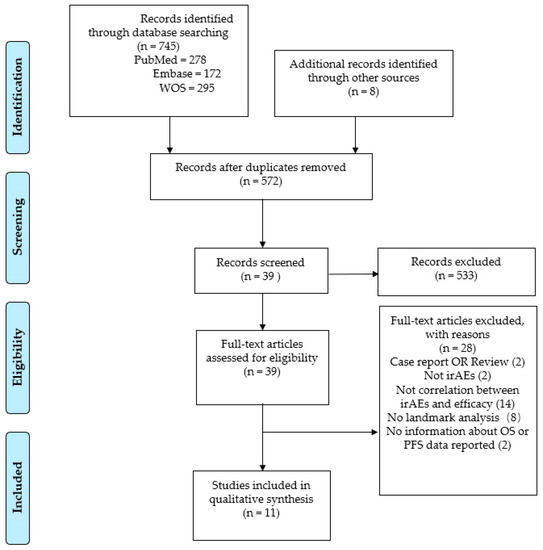
Figure 1.
The flow diagram.
3.2. Study Characteristics
The detailed characteristics of the included studies are presented in Table 1. Among these included studies, there were nine retrospective studies and two prospective studies. Specifically, Hosoya et al. conducted trials in retrospective and prospective cohorts. The included malignancies were non-small cell lung cancer (NSCLC, n = 8), renal cell carcinoma (n = 2), and advanced gastric cancer (n = 1). The sample sizes ranged from 43 to 559. The median follow-up interval varied from 9.9 to 32 months. The methodology quality of the included trials was generally moderate to good, and the main issue that affected the quality was the follow-up duration (Supplementary Table S2).

Table 1.
Main characteristics of the eligible studies.
3.3. Correlation of Early irAEs and Treatment Efficacy
OS (HR: 0.48, 95% CI: 0.39–0.56, p < 0.001) and PFS (HR: 0.53, 95% CI: 0.41–0.66, p < 0.001) (Figure 2) were higher in the patients who developed early irAEs than in those who did not. Moderate heterogeneity was observed in the overall treatment effect across the 11 comparisons (p = 0.054, I² = 42.0%); therefore, the random-effects model was preferred for the pooled analysis.
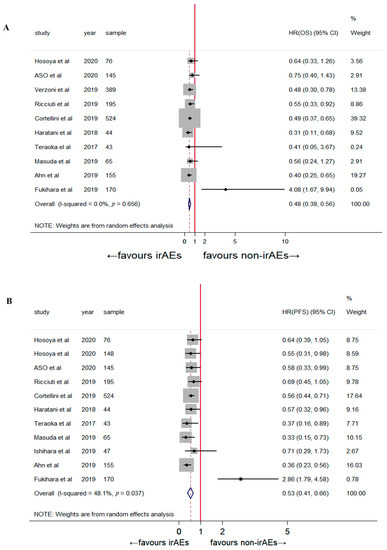
Figure 2.
The association between early-onset irAEs and (A) overall survival [2,8,13,14,15,16,17,20,21,22] and (B) progression-free survival [2,8,13,14,15,16,17,18,20,21].
3.4. Subgroup and Sensitivity Analyses
A subgroup analysis was performed based on the irAE type, tumor type, and sample size. Early dermatological irAEs were associated with significantly prolonged OS (HR: 0.51, 95% CI: 0.27–0.75, p < 0.001) and PFS (HR: 0.58, 95% CI: 0.41–0.75; p < 0.001; Figure 3). The sample sizes were not significantly correlated with patient prognosis (Figure 4). The stratified analysis of tumor type showed a favorable clinical outcome for OS (HR: 0.47, 95% CI: 0.38–0.57, p < 0.001) and PFS (HR: 0.55, 95% CI: 0.41–0.69, p < 0.001) in patients with NSCLC (Figure 5). The pooled results for both OS and PFS remained significant in the sensitivity analysis, regardless of the study, indicating a robust association between the development of early irAEs and prolonged OS and PFS (Supplementary Figure S1).
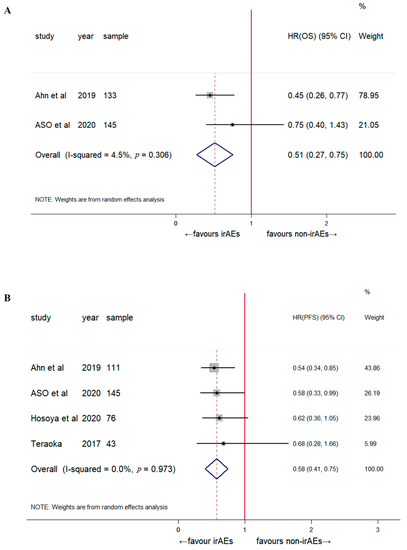
Figure 3.
Subgroup analysis of the association between early-onset dermatological irAEs and the clinical outcome of patients treated with immune checkpoint blockade. Overall survival (A) [2,16] and progression-free survival (B) [2,14,15,16].
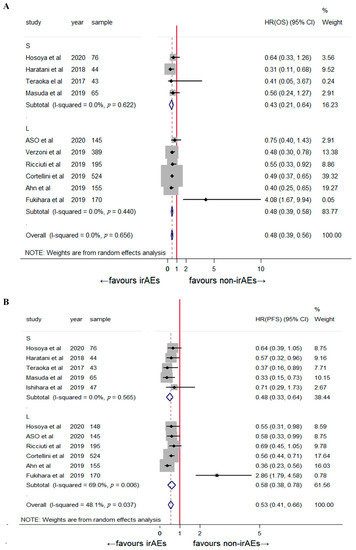
Figure 4.
Subgroup analysis of the association between early-onset irAEs and (A) overall survival [2,8,13,14,15,16,17,20,21,22] and (B) progression-free survival [2,8,13,14,15,16,17,18,20,21] stratified by sample size. S indicates small; L indicates large.
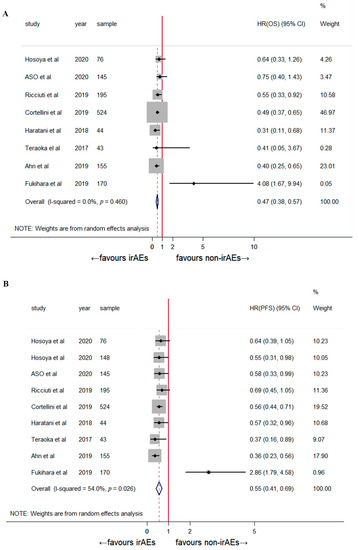
Figure 5.
Subgroup analysis of the association between early-onset irAEs and overall survival (A) [2,8,13,14,15,16,17,21] and progression-free survival (B) [2,8,13,14,15,16,17,21] in patients with non-small cell lung cancer.
3.5. Publication Bias
With an even distribution around the vertical axis, there was no substantial asymmetry in the visual inspection of Begg’s funnel plot (p = 0.653, Supplementary Figure S2). This was confirmed with Egger’s tests (p = 0.412), indicating no obvious publication bias.
4. Discussion
PD-1/PD-L1 inhibitors have revolutionized the treatment of various human cancers. Studies on irAEs developed during treatment with PD-1/PD-L1 inhibitors are critical for clinical decision-making. In our meta-analysis, the correlation between the efficacy of PD-1/PD-L1 inhibitors and early-onset irAEs was analyzed. We concluded that the occurrence of early irAEs is linked to better clinical outcomes, particularly cutaneous irAEs. Further subgroup analysis of tumor types and sample sizes demonstrated similar findings.
Previous studies have shown a positive association between irAE development and a favorable survival benefit. Specifically, Zhou et al. [10] performed a meta-analysis to pool the predictive effects of different irAE types and grades. The authors reported that the occurrence of endocrine, dermatological, and low-grade irAEs was significantly associated with a better clinical outcome in patients treated with ICIs. The time of onset of irAE is also a critical factor for the correlation between irAEs and clinical outcomes of treatment with ICI. Patients who develop irAEs are those who receive treatment with ICI for longer periods, and, thus, have a better prognosis than those who do not [13]. Thus, the so-called ‘guarantee-time bias’ may be induced if we do not consider the time of irAEs [26]. However, the reported time of onset of irAEs varies.
In our study, the development of early irAEs correlated significantly with prolonged PFS and OS. This makes sense because: (1) the occurrence of early irAEs reflects the function of T cells. According to the shared epitope theory, blockade of the PD-1/PD-L1 axis activates T cells wherein auto-antigens from normal tissues are eliminated at the same time. Thus, it is reasonable to consider that tumor cells are eliminated by activated T cells. (2) Patients who developed disease early after PD-1/PD-L1 inhibitor initiation often have a poor physical state, resulting in the discontinuation of anti-PD-1/PD-L1 therapy. Thus, these patients have little chance of developing irAEs because they only receive therapy for a short time. We also found that dermatological irAEs are associated with favorable outcomes. This can be attributed to the different severities of irAEs in different organs. Generally, dermatological irAEs are mild and manageable. In contrast, other types of irAEs, such as pulmonary and hepatobiliary irAEs, can be severe and even fatal. Patients developing these irAEs often have a poor physical state and are thus more likely to experience severe disease or death.
The immune checkpoint blockade induces the emergence of irAEs by unbalancing the immune system, although the exact mechanisms of the development of irAEs are still unclear. Cross-reactivity of the neoantigen-directed antitumor response with normal proteins may be one of the underlying mechanisms [27]. During checkpoint inhibitor therapy, T cells recognize the shared antigens and simultaneously target tumor cells and normal tissues [28]. CD8+ cytotoxic T lymphocyte-mediated cell lysis induces the release of neoantigens, tumor antigens, and auto-antigens, which are processed and presented by antigen-presenting cells from normal tissues [29]. This phenomenon of “epitope spreading” leads to the diversification of the T cell repertoire and reduces immune tolerance [30]. Thus, tumor regression is associated with the development of irAEs, and ICIs enhance the antitumor immune response as indicated by the presence of autoantibodies. The occurrence of irAEs is also thought to represent the bystander effects from activated T cells [9,27]. Normal tissue may experience severe inflammation when key negative regulators of T cell function are removed using ICI therapy. However, this is controversial because the previous meta-analysis reported a better ICI efficacy in patients with low-grade irAEs [10]. The composition of the gut microbiome may also play an important role in the efficacy of ICI therapy. Patients with specific microbiomes had improved clinical outcomes and ICI-induced colitis [31].
There are some limitations to our study. First, this is a meta-analysis, and patient-related variables were not included in the analysis. Second, the inherent limitations of the included studies limit the generalizability of our results. Third, some of the eligible trials had limited participants with a short follow-up duration, which may have resulted in the wide CIs of the HRs of the treatment effects, thereby confounding our pooled HRs. Finally, most of the studies were retrospective, which may increase the risk of bias.
In conclusion, early irAEs correlated significantly with prolonged OS and PFS in patients who received anti-PD-1/PD-L1 therapy. Future well-designed prospective studies are warranted to confirm our findings.
Supplementary Materials
The following supporting information can be downloaded at: https://www.mdpi.com/article/10.3390/jcm12030736/s1, Figure S1: The sensitivity analysis of the impact of each individual study on the pooled effect. A, Overall survival; B, progression-free survival. Figure S2. Funnel plots of the overall survival (A) and progression-free survival (B). Table S1: Search terms. Supplementary Table S2. The Newcastle-Ottawa Scale (NOS) quality assessment of the enrolled studies [2,8,13,14,15,16,17,18,20,21,22].
Author Contributions
Conceptualization, Y.-C.Z. and M.-Y.C.; methodology, R.-C.N. and L.-H.L.; validation, Y.-C.Z.; formal analysis, Y.-C.Z. and R.-C.N.; investigation, Y.-C.Z. and R.-C.N.; resources, D.X. and M.-Y.C.; data curation, Z.-C.X. and D.X.; writing—original draft preparation, Y.-C.Z.; writing—review and editing, R.-C.N., T.-C.Z., and M.-Y.C.; visualization, Y.-C.Z. and L.-H.L.; supervision, R.-Z.L. and M.-Y.C.; project administration, R.-Z.L. and M.-Y.C. All authors have read and agreed to the published version of the manuscript.
Funding
This research received no external funding.
Institutional Review Board Statement
All analyses were based on previous published studies, thus no ethical approval are required.
Informed Consent Statement
All analyses were based on previous published studies, thus no patient consent are required.
Data Availability Statement
This meta-analysis was not registered. A protocol was not prepared. No new data were created or analyzed in this study. Data sharing is not applicable to this article.
Conflicts of Interest
The authors declare no conflict of interest.
References
- Myers G: Immune-related adverse events of immune checkpoint inhibitors: A brief review. Curr. Oncol. 2018, 25, 342–347. [CrossRef] [PubMed]
- Aso, M.; Toi, Y.; Sugisaka, J.; Aiba, T.; Kawana, S.; Saito, R.; Ogasawara, T.; Tsurumi, K.; Ono, K.; Shimizu, H.; et al. Association between Skin Reaction and Clinical Benefit in Patients Treated with Anti-Programmed Cell Death 1 Monotherapy for Advanced Non-Small Cell Lung Cancer. Oncologist 2020, 25, e536–e544. [Google Scholar] [CrossRef] [PubMed]
- Chan, L.; Hwang, S.J.E.; Byth, K.; Kyaw, M.; Carlino, M.S.; Chou, S.; Fernandez-Penas, P. Survival and prognosis of individuals receiving programmed cell death 1 inhibitor with and without immunologic cutaneous adverse events. J. Am. Acad. Dermatol. 2020, 82, 311–316. [Google Scholar] [CrossRef]
- Das, S.; Ciombor, K.K.; Haraldsdottir, S.; Pumpalova, Y.; Sahin, I.H.; Pineda, G.; Shyr, Y.; Lin, E.P.; Hsu, C.Y.; Chu, S.K.; et al. Immune-Related Adverse Events and Immune Checkpoint Inhibitor Efficacy in Patients with Gastrointestinal Cancer with Food and Drug Administration-Approved Indications for Immunotherapy. Oncologist 2020, 25, 669–679. [Google Scholar] [CrossRef]
- Ezponda Casajús, A.; Calvo Imirizaldu, M.; de Torres Tajes, J.P.; García-Baizán, A.; Castañón Álvarez, E.; Cano Rafart, D.; Vivas Pérez, I.; Bastarrika Alemañ, G. Immune-related adverse events as predictors of response in cancer patients undergoing immunotherapy. Radiologia 2020, 62, 131–138. [Google Scholar] [CrossRef] [PubMed]
- Fujii, T.; Colen, R.R.; Bilen, M.A.; Hess, K.R.; Hajjar, J.; Suarez-Almazor, M.E.; Alshawa, A.; Hong, D.S.; Tsimberidou, A.; Janku, F.; et al. Incidence of immune-related adverse events and its association with treatment outcomes: The MD Anderson Cancer Center experience. Investig. New Drugs 2018, 36, 638–646. [Google Scholar] [CrossRef] [PubMed]
- Grangeon, M.; Tomasini, P.; Chaleat, S.; Jeanson, A.; Souquet-Bressand, M.; Khobta, N.; Bermudez, J.; Trigui, Y.; Greillier, L.; Blanchon, M.; et al. Association between Immune-related Adverse Events and Efficacy of Immune Checkpoint Inhibitors in Non-small-cell Lung Cancer. Clin. Lung Cancer 2019, 20, 201–207. [Google Scholar] [CrossRef]
- Haratani, K.; Hayashi, H.; Nakagawa, K. Association of immune-related adverse events with immune checkpoint inhibitor efficacy: Real or imaginary? BMC Med. 2020, 18, 111. [Google Scholar] [CrossRef]
- Das, S.; Johnson, D.B. Immune-related adverse events and anti-tumor efficacy of immune checkpoint inhibitors. J. Immunother. Cancer 2019, 7, 306. [Google Scholar] [CrossRef]
- Zhou, X.; Yao, Z.; Yang, H.; Liang, N.; Zhang, X.; Zhang, F. Are immune-related adverse events associated with the efficacy of immune checkpoint inhibitors in patients with cancer? A systematic review and meta-analysis. BMC Med. 2020, 18, 87. [Google Scholar] [CrossRef]
- Park, R.; Lopes, L.; Saeed, A. Anti-PD-1/L1-associated immune-related adverse events as harbinger of favorable clinical outcome: Systematic review and meta-analysis. Clin. Transl. Oncol. 2020, 23, 100–109. [Google Scholar] [CrossRef] [PubMed]
- Petrelli, F.; Grizzi, G.; Ghidini, M.; Ghidini, A.; Ratti, M.; Panni, S.; Cabiddu, M.; Ghilardi, M.; Borgonovo, K.; Parati, M.C.; et al. Immune-related Adverse Events and Survival in Solid Tumors Treated with Immune Checkpoint Inhibitors: A Systematic Review and Meta-Analysis. J. Immunother. 2020, 43, 1–7. [Google Scholar] [CrossRef]
- Cortellini, A.; Chiari, R.; Ricciuti, B.; Metro, G.; Perrone, F.; Tiseo, M.; Bersanelli, M.; Bordi, P.; Santini, D.; Giusti, R.; et al. Correlations between the Immune-related Adverse Events Spectrum and Efficacy of Anti-PD1 Immunotherapy in NSCLC Patients. Clin. Lung Cancer 2019, 20, 237–247.e231. [Google Scholar] [CrossRef] [PubMed]
- Teraoka, S.; Fujimoto, D.; Morimoto, T.; Kawachi, H.; Ito, M.; Sato, Y.; Nagata, K.; Nakagawa, A.; Otsuka, K.; Uehara, K.; et al. Early Immune-Related Adverse Events and Association with Outcome in Advanced Non–Small Cell Lung Cancer Patients Treated with Nivolumab: A Prospective Cohort Study. J. Thorac. Oncol. 2017, 12, 1798–1805. [Google Scholar] [CrossRef] [PubMed]
- Hosoya, K.; Fujimoto, D.; Morimoto, T.; Kumagai, T.; Tamiya, A.; Taniguchi, Y.; Yokoyama, T.; Ishida, T.; Hirano, K.; Matsumoto, H.; et al. Association between Early Immune-related Adverse Events and Clinical Outcomes in Patients with Non–Small Cell Lung Cancer Treated with Immune Checkpoint Inhibitors. Clin. Lung Cancer 2020, 21, e315–e328. [Google Scholar] [CrossRef]
- Ahn, B.C.; Pyo, K.H.; Xin, C.F.; Jung, D.; Shim, H.S.; Lee, C.Y.; Park, S.Y.; Yoon, H.I.; Hong, M.H.; Cho, B.C.; et al. Comprehensive analysis of the characteristics and treatment outcomes of patients with non-small cell lung cancer treated with anti-PD-1 therapy in real-world practice. J. Cancer Res. Clin. Oncol. 2019, 145, 1613–1623. [Google Scholar] [CrossRef]
- Fukihara, J.; Sakamoto, K.; Koyama, J.; Ito, T.; Iwano, S.; Morise, M.; Ogawa, M.; Kondoh, Y.; Kimura, T.; Hashimoto, N.; et al. Prognostic Impact and Risk Factors of Immune-Related Pneumonitis in Patients with Non-Small-Cell Lung Cancer Who Received Programmed Death 1 Inhibitors. Clin. Lung Cancer 2019, 20, 442–450.e444. [Google Scholar] [CrossRef]
- Ishihara, H.; Takagi, T.; Kondo, T.; Homma, C.; Tachibana, H.; Fukuda, H.; Yoshida, K.; Iizuka, J.; Kobayashi, H.; Okumi, M.; et al. Association between immune-related adverse events and prognosis in patients with metastatic renal cell carcinoma treated with nivolumab. Urol. Oncol. 2019, 37, e321–e355. [Google Scholar] [CrossRef]
- Ksienski, D.; Wai, E.S.; Croteau, N.; Fiorino, L.; Brooks, E.; Poonja, Z.; Fenton, D.; Geller, G.; Glick, D.; Lesperance, M. Efficacy of Nivolumab and Pembrolizumab in Patients with Advanced Non-Small-Cell Lung Cancer Needing Treatment Interruption Because of Adverse Events: A Retrospective Multicenter Analysis. Clin. Lung Cancer 2019, 20, e97–e106. [Google Scholar] [CrossRef]
- Masuda, K.; Shoji, H.; Nagashima, K.; Yamamoto, S.; Ishikawa, M.; Imazeki, H.; Aoki, M.; Miyamoto, T.; Hirano, H.; Honma, Y.; et al. Correlation between immune-related adverse events and prognosis in patients with gastric cancer treated with nivolumab. BMC Cancer 2019, 19, 974. [Google Scholar] [CrossRef]
- Ricciuti, B.; Genova, C.; De Giglio, A.; Bassanelli, M.; Dal Bello, M.G.; Metro, G.; Brambilla, M.; Baglivo, S.; Grossi, F.; Chiari, R. Impact of immune-related adverse events on survival in patients with advanced non-small cell lung cancer treated with nivolumab: Long-term outcomes from a multi-institutional analysis. J. Cancer Res. Clin. Oncol. 2019, 145, 479–485. [Google Scholar] [CrossRef] [PubMed]
- Verzoni, E.; Cartenì, G.; Cortesi, E.; Giannarelli, D.; De Giglio, A.; Sabbatini, R.; Buti, S.; Rossetti, S.; Cognetti, F.; Rastelli, F.; et al. Real-world efficacy and safety of nivolumab in previously-treated metastatic renal cell carcinoma, and association between immune-related adverse events and survival: The Italian expanded access program. J. Immunother. Cancer 2019, 7, 99. [Google Scholar] [CrossRef] [PubMed]
- Haratani, K.; Hayashi, H.; Chiba, Y.; Kudo, K.; Yonesaka, K.; Kato, R.; Kaneda, H.; Hasegawa, Y.; Tanaka, K.; Takeda, M.; et al. Association of Immune-Related Adverse Events with Nivolumab Efficacy in Non-Small-Cell Lung Cancer. JAMA Oncol. 2018, 4, 374–378. [Google Scholar] [CrossRef] [PubMed]
- Moher, D.; Liberati, A.; Tetzlaff, J.; Altman, D.G. Preferred reporting items for systematic reviews and meta-analyses: The PRISMA statement. PLoS Med. 2009, 6, e1000097. [Google Scholar] [CrossRef] [PubMed]
- Parmar, M.K.; Torri, V.; Stewart, L. Extracting summary statistics to perform meta-analyses of the published literature for survival endpoints. Stat. Med. 1998, 17, 2815–2834. [Google Scholar] [CrossRef]
- Giobbie-Hurder, A.; Gelber, R.D.; Regan, M.M. Challenges of guarantee-time bias. J. Clin. Oncol. 2013, 31, 2963–2969. [Google Scholar] [CrossRef] [PubMed]
- Yoest, J.M. Clinical features, predictive correlates, and pathophysiology of immune-related adverse events in immune checkpoint inhibitor treatments in cancer: A short review. Immunotargets Ther. 2017, 6, 73–82. [Google Scholar] [CrossRef]
- Berner, F.; Bomze, D.; Diem, S.; Ali, O.H.; Faessler, M.; Ring, S.; Niederer, R.; Ackermann, C.J.; Baumgaertner, P.; Pikor, N.; et al. Association of Checkpoint Inhibitor-Induced Toxic Effects with Shared Cancer and Tissue Antigens in Non-Small Cell Lung Cancer. JAMA Oncol. 2019, 5, 1043–1047. [Google Scholar] [CrossRef]
- Yang, H.; Yao, Z.; Zhou, X.; Zhang, W.; Zhang, X.; Zhang, F. Immune-related adverse events of checkpoint inhibitors: Insights into immunological dysregulation. Clin. Immunol. 2020, 213, 108377. [Google Scholar] [CrossRef]
- Passat, T.; Touchefeu, Y.; Gervois, N.; Jarry, A.; Bossard, C.; Bennouna, J. Physiopathological mechanisms of immune-related adverse events induced by anti-CTLA-4, anti-PD-1 and anti-PD-L1 antibodies in cancer treatment. Bull. Cancer 2018, 105, 1033–1041. [Google Scholar] [CrossRef]
- Chaput, N.; Lepage, P.; Coutzac, C.; Soularue, E.; Le Roux, K.; Monot, C.; Boselli, L.; Routier, E.; Cassard, L.; Collins, M.; et al. Baseline gut microbiota predicts clinical response and colitis in metastatic melanoma patients treated with ipilimumab. Ann. Oncol. 2019, 30, 2012. [Google Scholar] [CrossRef] [PubMed]
Disclaimer/Publisher’s Note: The statements, opinions and data contained in all publications are solely those of the individual author(s) and contributor(s) and not of MDPI and/or the editor(s). MDPI and/or the editor(s) disclaim responsibility for any injury to people or property resulting from any ideas, methods, instructions or products referred to in the content. |
© 2023 by the authors. Licensee MDPI, Basel, Switzerland. This article is an open access article distributed under the terms and conditions of the Creative Commons Attribution (CC BY) license (https://creativecommons.org/licenses/by/4.0/).